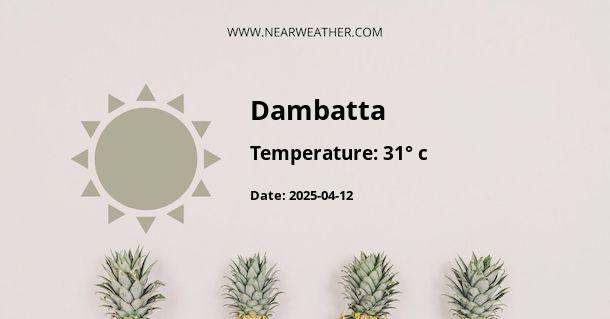Dambarta, Nigeria: Climate and Weather Year Round
Dambarta is a small town located in Nigeria, known for its diverse culture and rich history. Like many other regions in Nigeria, Dambarta experiences a tropical savanna climate. In this article, we will explore the climate and weather patterns in Dambarta throughout the year, highlighting the key factors that influence them.
Temperature
One of the defining characteristics of Dambarta's climate is its high temperatures throughout the year. The town experiences hot and dry weather for the majority of the year, with average temperatures ranging from 25 to 35 degrees Celsius (77 to 95 degrees Fahrenheit). The hottest months in Dambarta are typically between February and April, with temperatures often exceeding 40 degrees Celsius (104 degrees Fahrenheit). It is important to note that these temperature ranges are approximate and can vary slightly from year to year.
During the cooler months, from November to January, temperatures in Dambarta can drop to around 20 degrees Celsius (68 degrees Fahrenheit) during the day and even lower at night. These relatively cooler months offer some relief from the scorching heat of the rest of the year.
Rainfall
The climate in Dambarta is characterized by distinct wet and dry seasons. The town experiences a rainy season from May to September, with the heaviest rainfall occurring between June and August. During this period, Dambarta receives an average of 800 to 1000 millimeters (31 to 39 inches) of rainfall. The rain showers are often intense and accompanied by thunderstorms, which provide much-needed relief from the heat.
On the other hand, the dry season in Dambarta lasts from October to April, with significantly reduced rainfall. The months of December and January are the driest, with little to no rainfall. This prolonged dry season can result in water scarcity and drought conditions in the region.
Humidity
Dambarta experiences relatively high humidity levels throughout the year, especially during the wet season. Humidity levels can range from 60% to 80% during this period, making the weather feel even hotter and stickier. However, during the dry season, humidity levels tend to drop, providing some relief from the oppressive heat.
Wind Patterns
Dambarta is influenced by the prevailing wind patterns in Nigeria. From October to March, the Harmattan winds blow from the northeast, bringing dry and dusty air from the Sahara Desert. These winds can lead to reduced visibility and cooler temperatures during the dry season.
During the wet season, the winds shift, and the southwesterly monsoon winds prevail. These winds bring moist air from the Atlantic Ocean, resulting in increased humidity and the onset of rainfall in Dambarta.
Climate Adaptation
The climate in Dambarta presents challenges for the local population, especially in terms of agriculture and water resources. The long dry season requires careful water management and irrigation techniques to sustain crops and livestock. The wet season, although providing ample rainfall, can also lead to flooding and waterlogging in some areas.
Efforts are being made to promote climate adaptation strategies in Dambarta, such as the construction of reservoirs and dams for water storage, as well as the implementation of sustainable agricultural practices.
Conclusion
Dambarta, Nigeria, experiences a tropical savanna climate characterized by high temperatures, distinct wet and dry seasons, and varying wind patterns. The town's climate presents challenges for the local population, particularly in terms of water scarcity and agricultural practices. By understanding the climate patterns in Dambarta, efforts can be made to develop sustainable strategies to adapt to the region's unique weather conditions.
A - Dambatta's Latitude is 12.433030 & Longitude is 8.515410.
A - Weather in Dambatta is 31° today.
A - Climate Conditions in Dambatta shows scattered clouds today.
A - Humidity in Dambatta is 8% today.
A - Wind speed in Dambatta is 13.68 km/h, flowing at 48° wind direction. today.
